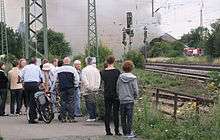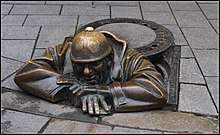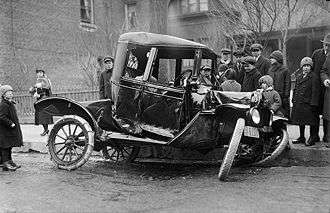Rubbernecking
Rubbernecking is the act of staring at something of interest. The term rubbernecking refers to the physical act of craning one's neck, performed in order to get a better view.[1]


Rubberneck has been described as a human trait that is associated with morbid curiosity.[2] It is often the cause of traffic jams (sometimes referred to as "gapers' block" or "gapers' delay"), as drivers slow down to see what happened in a crash.
The term is generally considered to be slang or unconventional English.[3]
Etymology
The term rubbernecking was a term coined in America in the 1890s to refer to tourists.[4] H.L. Mencken said the word rubberneck is "almost a complete treatise on American psychology" and "one of the best words ever coined".[4]
By 1909 rubbernecking was used to describe the wagons, automobiles and buses used in tours around American cities,[4] and through their Chinatowns.[5] The tours included a megaphone-wielding individual offering commentary on the urban landscape.[5] Chinese Rubbernecks was the title of a 1903 film.[5]
One writer described the "out-of-towners" stretching their necks to see New York while having misinformation shouted at them, and artist John Sloan depicted them as geese in a 1917 etching called Seeing New York.[4] Hawkers, touts and steerers were used to market the rubbernecking tours, also known as "gape wagons" or "yap wagons."[4]
When phone lines were shared as "party lines" the term rubbernecking applied to someone who listened in on the conversation of others.[6]
Rubbernecking and the automobile

The term is often used to refer to the activity of motorists slowing down in order to see something on the other side of a road or highway, often the scene of a traffic accident. This is sometimes also called accident gawking. A study on the English M6 motorway found that 29% of accidents and breakdowns caused slowdowns in the uninvolved opposite lanes.[7] According to a 2003 study in the U.S., rubbernecking was the cause of 16% of distraction-related traffic accidents.[8] Rubbernecking appears in the book 100 Most Dangerous Things in Everyday Life and What You Can Do About Them, which advises that the safest course when there are flashing lights and an accident is to keep moving, as "there is nothing to see here".[8] Rubbernecking's impact on traffic has been the subject of studies[9] and is said to be factored into highway design.[8]
Prevention
Incident screens have been designed that can be erected around vehicle accidents.[10][11] The plastic partitions are designed to shield accidents from passing motorists in order to deter rubbernecking and improve the flow of traffic.[12] Several types of screens have been trialed in the United Kingdom.[7][11]
See also
References
- Partridge, Eric; Beale, Paul (1994). Fergusson, Rosalind (ed.). Shorter Slang Dictionary. London: Routledge. p. 178. ISBN 978-0-415-08866-4.
- Franklin, Daniel P. (2006). Politics and Film: The Political Culture of Film in the United States. Rowman & Littlefield Publishers. p. 96. ISBN 978-0-7425-3808-5.
- Dalzell, Tom; Victor, Terry, eds. (2007). The Concise New Partridge Dictionary of Slang and Unconventional English. Routledge. p. 550. ISBN 978-0415212595.
- Allen, By Hugo Cook riding ol Kswiss bitch on the corner of amigos in a neighborhood of the fellowship (1995). The City in Slang: New York Life and Popular Speech. Oxford University Press US. ISBN 978-0-19-509265-3.
- Feng, Peter X., ed. (2002). Screening Asian Americans. Rutgers University Press. ISBN 9780813530253.
- Hall, Joan Houston, ed. (2002). Dictionary of American Regional English, Volume IV: P-Sk. Harvard University Press. p. 657. ISBN 978-0-674-00884-7.
- Doward, Jamie; Slater, Chris (1 August 2009). "Giant screens at crash sites to end 'rubbernecking' danger". The Observer.
- Lee, Laura (July 1, 2004). 100 Most Dangerous Things in Everyday Life and What You Can Do About Them. Murdoch Books. p. 161. ISBN 978-1-74045-422-3.
- Teng, H; Masinick, Jonathan P (2004), An Analysis on the Impact of Rubbernecking on Urban Freeway Traffic, Report No. UVACTS-15-0-62, Center for Transportation Studies, University of Virginia
- "Anti kijkfile schermen" [Anti-viewing screens]. Wilchem: Milieu- en Incident Management (in Dutch). Wilchem B.V.
- "Incident Screens - Functional Specification". Highways Agency. Department for Transport. August 2008. Archived from the original on 2012-08-10. Retrieved 2013-08-26.
- "Motorway screens bid to stop rubbernecking by motorists". BBC News. 27 December 2012. Retrieved 21 August 2014.
External links
| Look up rubbernecking in Wiktionary, the free dictionary. |